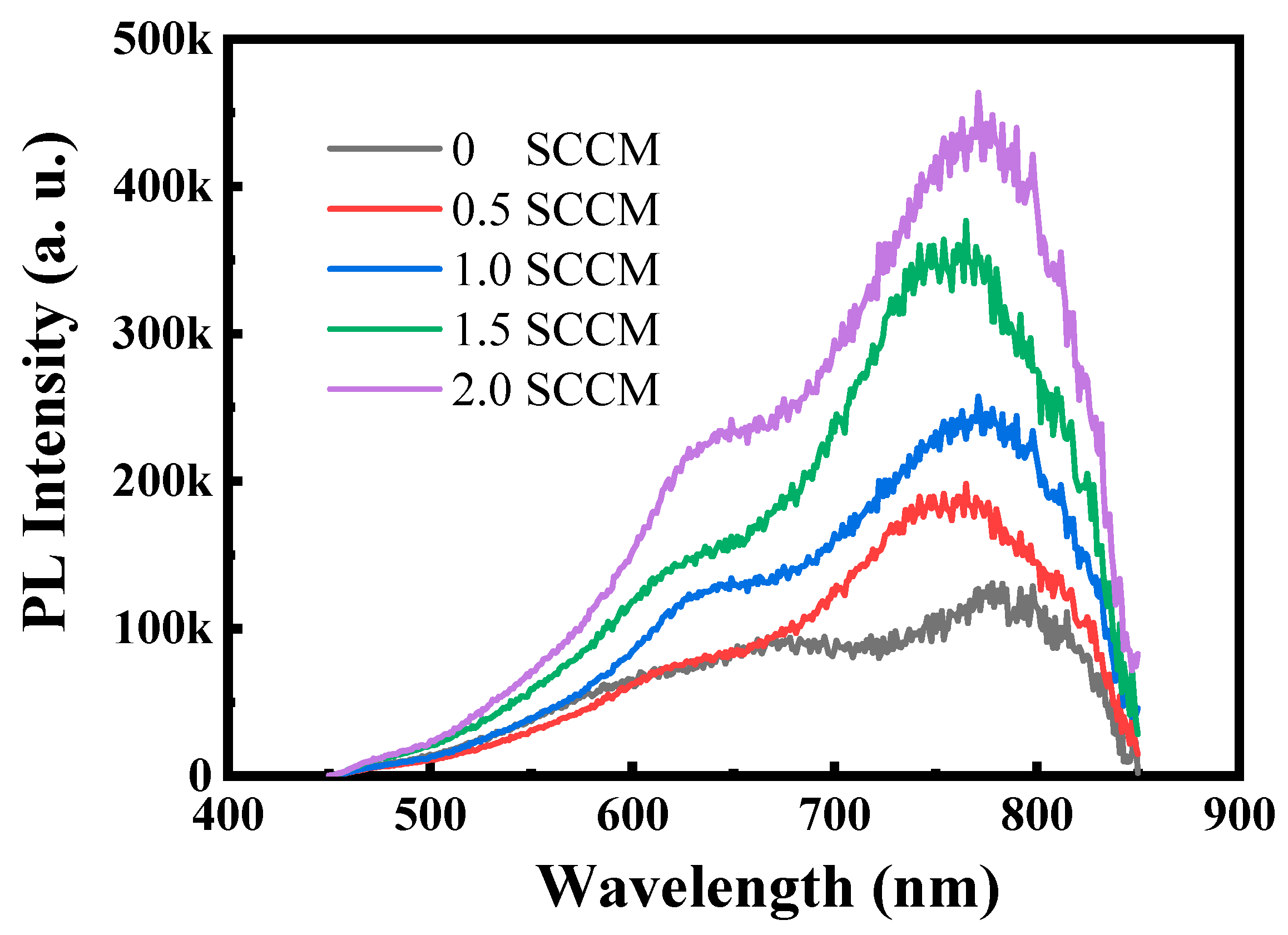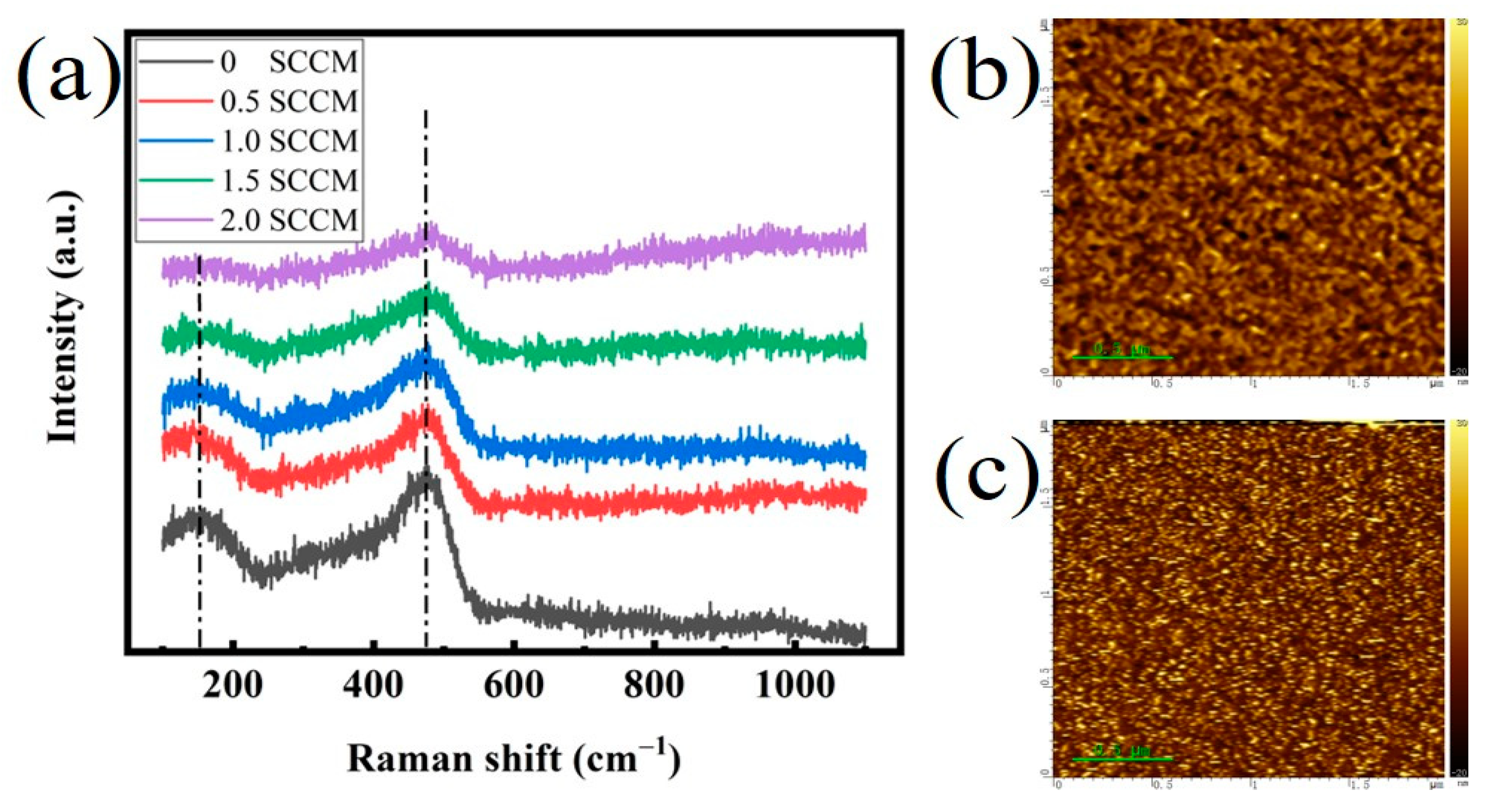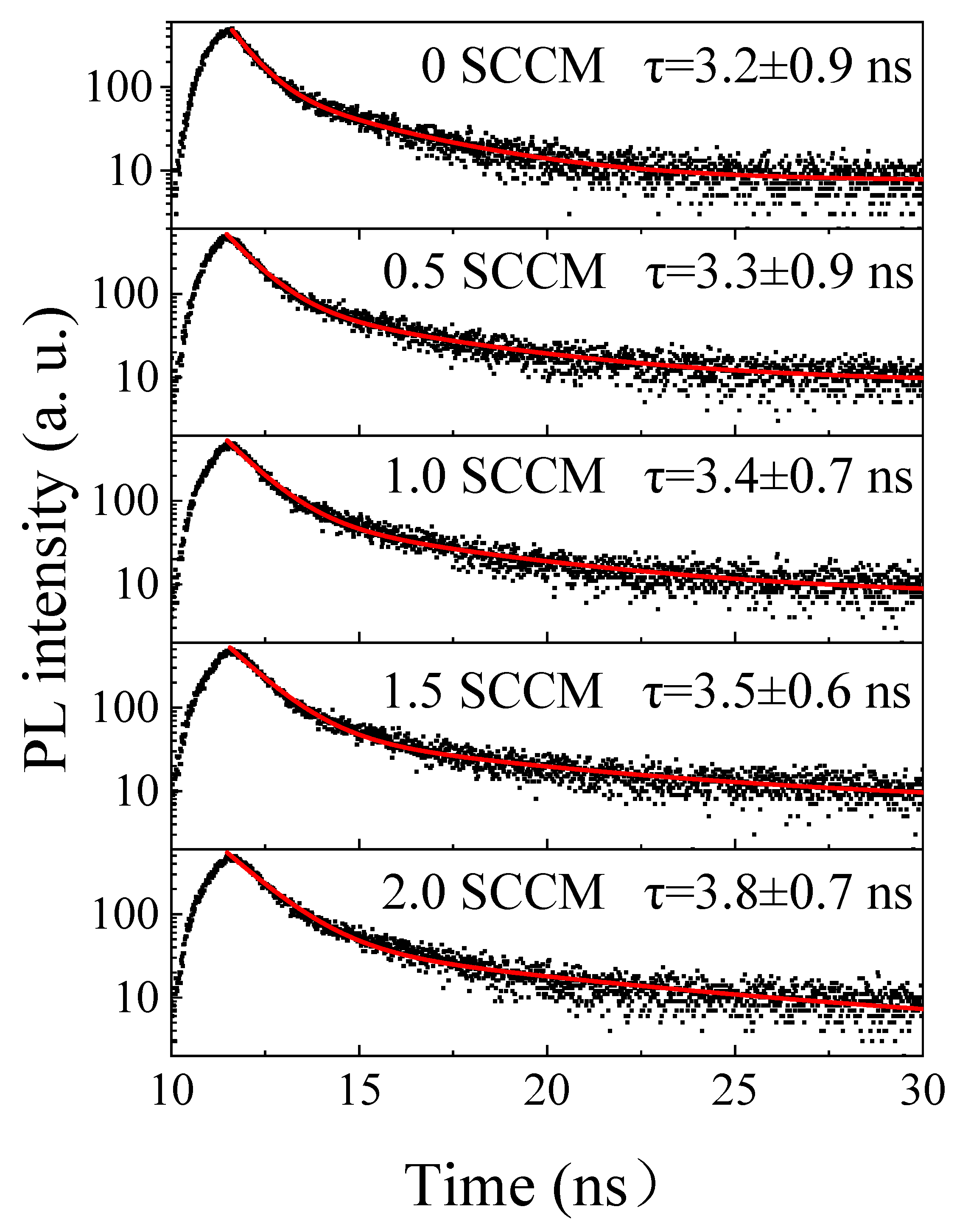Enhanced Red Emission from Amorphous Silicon Carbide Films via Nitrogen Doping
Abstract
:1. Introduction
2. Experimental Details
3. Results and Discussion
4. Conclusions
Author Contributions
Funding
Data Availability Statement
Conflicts of Interest
References
- Ni, Z.; Zhou, S.; Zhao, S.; Peng, W.; Yang, D.; Pi, X. Silicon nanocrystals: Unfading silicon materials for optoelectronics. Mater. Sci. Eng. R Rep. 2019, 138, 85–117. [Google Scholar] [CrossRef]
- Nevin, W.A.; Yamagishi, H.; Yamaguchi, M.; Tawada, Y. Emission of blue light from hydrogenated amorphous silicon carbide. Nature 1994, 368, 529–531. [Google Scholar] [CrossRef]
- Giorgis, F.; Mandracci, P.; Negro, L.D.; Mazzoleni, C.; Pavesi, L. Optical absorption and luminescence properties of wide-band gap amorphous silicon based alloys. J. Non-Cryst. Solids 2000, 266–269, 588–592. [Google Scholar] [CrossRef]
- Fan, J.Y.; Wu, X.L.; Chu, P.K. Low-dimensional SiC nanostructures: Fabrication, luminescence, and electrical properties. Prog. Mater. Sci. 2006, 51, 983–1031. [Google Scholar] [CrossRef]
- Vasin, A.V.; Kolesnik, S.P.; Konchits, A.A.; Rusavsky, A.V.; Lysenko, V.S.; Nazarov, A.N.; Ishikawa, Y.; Koshka, Y. Structure, paramagnetic defects and light-emission of carbon-rich 𝑎-SiC:H films. J. Appl. Phys. 2008, 103, 123710. [Google Scholar] [CrossRef]
- Beke, D.; Szekrényes, Z.; Czigány, Z.; Kamarás, K.; Gali, Á. Dominant luminescence is not due to quantum confinement in molecular-sized silicon carbide nanocrystals. Nanoscale 2015, 7, 10982–10988. [Google Scholar] [CrossRef] [PubMed] [Green Version]
- Wang, J.; Suendo, V.; Abramov, A.; Yu, L.; Roca i Cabarrocas, P. Strongly enhanced tunable photoluminescence in polymorphous silicon carbon thin films via excitation-transfer mechanism. Appl. Phys. Lett. 2010, 97, 221113. [Google Scholar] [CrossRef]
- Lin, Z.; Huang, R.; Zhang, Y.; Song, J.; Li, H.; Guo, Y.; Song, C. Defect emission and optical gain in SiCxOy: H films. ACS Appl. Mat. Interfaces 2017, 9, 22725–22731. [Google Scholar] [CrossRef] [PubMed]
- Li, D.; Chen, J.; Sun, T.; Zhang, Y.; Xu, J.; Li, W.; Chen, K. Enhanced subband light emission from Si quantum dots/SiO2 multilayers via phosphorus and boron co-doping. Opt. Express 2022, 30, 12308–12315. [Google Scholar] [CrossRef] [PubMed]
- Lin, G.R.; Pai, Y.H.; Lin, C.T.; Chen, C.C. Comparison on the electroluminescence of Si-rich SiNx and SiOx based light-emitting diodes. Appl. Phys. Lett. 2010, 96, 263514. [Google Scholar] [CrossRef]
- Wang, F.; Li, N.; Jin, L.; Yang, D.; Que, D. Reduction of the efficiency droop in silicon nitride light-emitting devices by localized surface plasmons. Appl. Phys. Lett. 2013, 102, 081108. [Google Scholar] [CrossRef]
- Huh, C.; Kim, B.K.; Park, B.-J.; Jang, E.-H.; Kim, S.-H. Enhancement in electron transport and light emission efficiency of a Si nanocrystal light-emitting diode by a SiCN/SiC superlattice structure. Nanoscale Res. Lett. 2013, 8, 14. [Google Scholar] [CrossRef] [PubMed] [Green Version]
- Zhang, Y.; Zhang, C.; Li, S.; Dai, X.; Ma, X.; Gao, R.; Zhou, W.; Lu, M. Enhancing light emission of Si nanocrystals by means of high-pressure hydrogenation. Opt. Express 2020, 28, 23320–23328. [Google Scholar] [CrossRef] [PubMed]
- Li, Q.; Luo, T.Y.; Zhou, M.; Abroshan, H.; Huang, J.; Kim, H.J.; Rosi, N.L.; Shao, Z.; Jin, R. Silicon Nanoparticles with Surface Nitrogen: 90% Quantum Yield with Narrow Luminescence Bandwidth and the Ligand Structure Based Energy Law. ACS Nano 2016, 10, 8385–8393. [Google Scholar] [CrossRef] [PubMed]
- Molinari, M.; Rinnert, H.; Vergnat, M. Improvement of the photoluminescence properties in a-SiNx films by introduction of hydrogen. Appl. Phys. Lett. 2001, 79, 2172. [Google Scholar] [CrossRef] [Green Version]
- Huang, R.; Song, J.; Wang, X.; Guo, Y.Q.; Song, C.; Zheng, Z.H.; Wu, X.L.; Chu, P.K. Origin of strong white electroluminescence from dense Si nanodots embedded in silicon nitride. Opt. Lett. 2012, 37, 692–694. [Google Scholar] [CrossRef] [PubMed] [Green Version]
- Haberl, B.; Bogle, S.N.; Li, T.; McKerracher, I.; Ruffell, S.; Munroe, P.; Williams, J.S.; Abelson, J.R.; Bradby, J.E. Unexpected short- and medium-range atomic structure of sputtered amorphous silicon upon thermal annealing. J. Appl. Phys. 2011, 110, 096104. [Google Scholar] [CrossRef]
- Rui, Y.; Chen, D.; Xu, J.; Zhang, Y.; Yang, L.; Mei, J.; Ma, Z.; Cen, Z.; Li, W.; Xu, L.; et al. Hydrogen-induced recovery of photoluminescence from annealed a-Si:H∕a-SiO2 multilayers. J. Appl. Phys. 2005, 98, 033532. [Google Scholar] [CrossRef]
- Ren, Y.; Weber, K.J.; Nursam, N.M.; Wang, D. Effect of deposition conditions and thermal annealing on the charge trapping properties of SiNx films. Appl. Phys. Lett. 2010, 97, 202907. [Google Scholar] [CrossRef] [Green Version]
- Lin, Z.; Huang, R.; Song, J.; Guo, Y.; Lin, Z.; Zhang, Y.; Xia, L.; Zhang, W.; Li, H.; Song, C.; et al. Engineering CsPbBr3 quantum dots with efficient luminescence and stability by damage-free encapsulation with a-SiCx:H. J. Lumin. 2021, 236, 118086. [Google Scholar] [CrossRef]





Publisher’s Note: MDPI stays neutral with regard to jurisdictional claims in published maps and institutional affiliations. |
© 2022 by the authors. Licensee MDPI, Basel, Switzerland. This article is an open access article distributed under the terms and conditions of the Creative Commons Attribution (CC BY) license (https://creativecommons.org/licenses/by/4.0/).
Share and Cite
Chen, G.; Chen, S.; Lin, Z.; Huang, R.; Guo, Y. Enhanced Red Emission from Amorphous Silicon Carbide Films via Nitrogen Doping. Micromachines 2022, 13, 2043. https://doi.org/10.3390/mi13122043
Chen G, Chen S, Lin Z, Huang R, Guo Y. Enhanced Red Emission from Amorphous Silicon Carbide Films via Nitrogen Doping. Micromachines. 2022; 13(12):2043. https://doi.org/10.3390/mi13122043
Chicago/Turabian StyleChen, Guangxu, Sibin Chen, Zewen Lin, Rui Huang, and Yanqing Guo. 2022. "Enhanced Red Emission from Amorphous Silicon Carbide Films via Nitrogen Doping" Micromachines 13, no. 12: 2043. https://doi.org/10.3390/mi13122043




